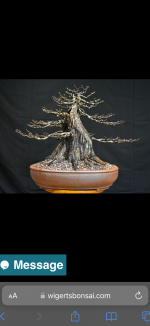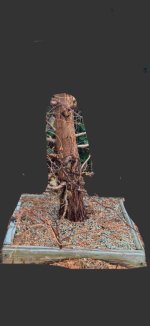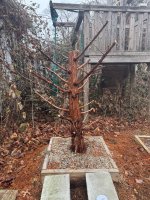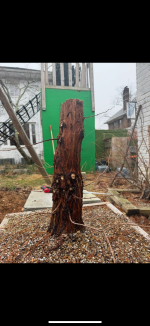Indeed. If I am going to be brutal with the roots, it is for sure too deep. A big box filled with soil is ridiculously heavy. The dolly idea is excellent.10" deep box seems big imo and will have a lot of extra weight.
Weight wise, put some 1" galvanized pipe clamps on the side so you can slide two 5ft long pipes along the box and allow an easy lift onto a dolly/cart for transport.
You are using an out of date browser. It may not display this or other websites correctly.
You should upgrade or use an alternative browser.
You should upgrade or use an alternative browser.
Dawn Redwood #1
- Thread starter dbonsaiw
- Start date
His post really made me feel better. Knowing that I can go at the roots hard and get this into a reasonably sized grow box (seconded by Orion) is better than xanax - I can rest easier now.@johng also is a great resource for this type of tree development...
This discussion had me researching how to heal larger wounds and I came across this David Easterbrook video which I found interesting (on a trident maple). Anyone have experience with this technique? I never thought about grafting DR branches, but why not?
Yup. And you can’t put it back on after the chop.What's it worth??? You can always go lower
Indeed. I have a few months to think about it but this was my first doodle on the train ride this morning.There's lots there to work with...
misfit11
Omono
This is the most impressive single BC bonsai (Ryan Neil has a forest that is very nice) that I've ever seen. Typically BC bonsai are these tall slender straight trees with a hat of foliage on top. I've never seen flat top BC in person, so I don't have the fondness that people who grew up with them have. To me, they are rather uninteresting trees and don't make compelling bonsai, IMO. This, with fantastic taper, great ramification, and nice branch structure is a great tree. The time required to heal a large chop, like this one obviously did, is probably a deal breaker for most people.I love this BC from wiggerts and assume it was created by initially making a very large chop low down on a large trunk. I was thinking of this for my DR at one point. Not sure I have the stomach to chop my tree so low.
The $10k price tag was the deal breaker for me, but it appears to have been sold. I have come to the conclusion that I need multiple specimens of each species I am working with. I simply will never be satisfied with whatever style I choose and will need to develop alternatives in order to be happy. I currently have only 3 DR (all purchased at the same time as seedlings), but each is on a very different path. One has been grown to ridiculous size. One found its way into a pot already. And the third has achieved enough girth to get going on a cut and grow. With this specific tree, I simply don't want to kill it. It has a ton of low branching and if I can convince myself that it will live and thrive, I would be inclined to cut this low.The time required to heal a large chop, like this one obviously did, is probably a deal breaker for most people.
I'm kind of the same page regarding the flat top style. That said, I am planning to develop a vachelia to have a flat top. Variety is the spice of life.
The Barber
Chumono
With as much vigor as it is showing, a low cut in early spring shouldn't be an issue i wouldn't think, it should have plenty of energy stored. Just be sure and seal the wound really well.The $10k price tag was the deal breaker for me, but it appears to have been sold. I have come to the conclusion that I need multiple specimens of each species I am working with. I simply will never be satisfied with whatever style I choose and will need to develop alternatives in order to be happy. I currently have only 3 DR (all purchased at the same time as seedlings), but each is on a very different path. One has been grown to ridiculous size. One found its way into a pot already. And the third has achieved enough girth to get going on a cut and grow. With this specific tree, I simply don't want to kill it. It has a ton of low branching and if I can convince myself that it will live and thrive, I would be inclined to cut this low.
I'm kind of the same page regarding the flat top style. That said, I am planning to develop a vachelia to have a flat top. Variety is the spice of life.
How low is low? My doctored pic above is about 20 inches tall.a low cut in early spring shouldn't be an issue i wouldn't think
The Barber
Chumono
If you're going for something similar to the short one from Wiggerts that you posted. I would cut it to about half of what the doctored photo is, or less, flat cut and seal the cut.How low is low? My doctored pic above is about 20 inches tall.
Once it has done some branching:
1.You'll want a cut between the new leader and a low branch at the angle you want, branches near cut sites will help the wound heal. As much vigor as your tree has shown, it should push plenty of branches with the reserves it has in the spring, so you'll have plenty of options on your cut.
Depending on the goal you have multiple options.
(Photo of Wiggert's tree edited with AI to show the branches to angle between as an example.)

Option A. If you wish to have it heal over the cut site then seal the entire cut well. Decide how you want the trunk to heal, and leave wood in the shape you want the tree to end up as, keeping in mind how thick the tree callouses over. Example, leave the cut more dished outwards to have it heal into a more conical shape giving it a more natural taper, a flat cut will heal over more flat
Option B. If you want to form a hollow at the cut site, only seal the edge of the cut, and any wood you want to keep for the tree to callous onto. You can help the hollow along by boring/drilling out the inside of the cut, later and then let nature do the rest. It will roll over into the hollow as it heals.
The tree size doesn't matter, scale does. It is all the same concept really, let it beef up to whatever size you plan on the base remaining once removed from the ground. Dawn redwood tend to push branches from everywhere even more than bald cypress, at least mine have. I can chop one of mine low if you want a demonstration in the spring, because now this kind of has me wanting to do a stocky dawn redwood.
@johng can chime in if I missed anything. He's definitely a pro on these types of trees.
If you're going for something similar to the short one from Wiggerts that you posted. I would cut it to about half of what the doctored photo is, or less, flat cut and seal the cut.
Wow, thank you for that explanation. Decisions decisions.
Here’s where I currently stand on the tree. It’s still quite tall, but I’ll see where the new leader grows and make further decisions. The cut is truly massive and will take forever to heal (if ever???) so I left it in the ground for now. Buds are popping all around the pruned branches - I’ll need to start paying closer attention to these as there is already some reverse taper going on.
P.S. I will never grow a tree so large in this manner again.
P.S. I will never grow a tree so large in this manner again.
Attachments
Similar threads
- Replies
- 1
- Views
- 228





